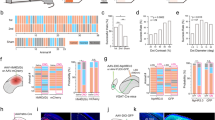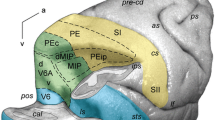Summary
We examined cortical and subcortical mediation of visual locomotor orienting function by comparing the behavior of hamsters with discrete bilateral lesions affecting the pretectum, superior colliculus (SC), or visual cortex (VC). Orienting and approach to stationary targets was evaluated by measuring the accuracy of hamsters' approaches to small black apertures, located at eye level along the wall of a circular white arena. Hamsters with bilateral ablation of the visual cortex were slightly impaired for approaches to central field targets, whereas those with ibotenic acid lesions of the pretectum (which spares fibers of passage and thus leaves tectal afferents intact) were totally unimpaired. Hamsters with transection of the brachium of SC (BSC) at the prectectal-SC (PT-SC) border were severely impaired in their ability to approach stationary targets in central and peripheral fields. Thus, we did not detect any of the central field sparing that has been reported by others for rodents with similar lesions. Several possible reasons for the disparity between our results and those of others are discussed. Overall, our results indicate that in hamsters the SC is essential for normal visually guided approach to dark, stationary targets throughout the visual field. Further, our results and qualitative observations indicate that the approach errors are most likely due to deficits of visuomotor integration rather than to a lack of visual scanning.
Similar content being viewed by others
References
Beckstead RM, Frankfurter A (1983) A direct projection from the retina to the intermediate gray layer of the superior colliculus demonstrated by anterograde transport of horseradish peroxidase in monkey, cat and rat. Exp Brain Res 52:261–268
Cadusseau J, Roger M (1985) Afferent projections to the superior colliculus in the rat, with special attention to the deep layers. J Hirnforsch 26:667–681
Carman LS, Schneider GE (1992) Spared orienting functions of hamsters with neonatal lesions of the superior colliculus are mediated by aberrant midbrain projections. Exp Brain Res (in press)
Casagrande VA, Diamond IT (1974) Ablation study of the superior colliculus in the tree shrew. J Comp Neurol 156:207–237
Chalupa LM, Rhoades RW (1977) Responses of visual, somatosensory and auditory neurons in the golden hamster's superior colliculus. J Physiol (Lond) 270:595–626
Dean P, Key C (1981) Spatial deficits on radial maze after large tectal lesions in rats: possible role of impaired scanning. Behav Neural Biol 32:170–190
Dean P, Pope SG (1981) Visual discrimination learning in rats with lesions of the superior colliculus: door-push and approach errors in modified jumping stand. Quart J Exp Psychol 33B:141–157
Dean P, Redgrave P (1984a) The superior colliculus and visual neglect in rat and hamster. I. Behavioral Evidence. Brain Res Rev 8:129–141
Dean P, Redgrave P (1984b) The superior colliculus and visual neglect in rat and hamster. II. Possible mechanisms. Brain Res Rev 8:143–153
Fink RP, Heimer L (1967) Two methods for selective silver impregnation of degenerating axons and their synaptic endings in the central nervous system. Brain Res 4:369–374
Finlay BL, Schneps SE, Wilson KG, Schneider GE (1978) Topography of visual and somatosensory projections to the superior colliculus of the golden hamster. Brain Res 142:223–235
Finlay BL, Wilson KG, Schneider GE (1979) Anomalous ipsilateral retinotectal projections in syrian hamsters with early lesions: topography and functional capacity. J Comp Neurol 183:721–740
Finlay BL, Marder K, Cordon D (1980a) Aquisition of visuomotor behavior after neonatal tectal lesions in the hamster: the role of visual experience. J Comp Physiol Psych 94:506–518
Finlay BL, Sengelaub DR, Berg AT, Cairns SJ (1980b) A neuroethological approach to hamster vision. Behav Brain Res 1:479–496
Foreman N (1983) Distractibility following simultaneous bilateral lesions of the superior colliculus or medial frontal cortex of the rat. Behav Brain Res 8:177–194
Goodale MA (1983) Neural mechanisms of visual orientation in rodents: targets versus places. In: Hein A, Jennerod M (eds) Spatially oriented behavior. Springer, Berlin Heidelberg New York, pp 35–61
Goodale MA, Milner AD (1982) Fractionating orientation behavior in rodents. In: Ingle DJ, Goodale MA, Mansfield RJW (eds) Analysis of visual behavior. MIT Press, Cambridge, pp 267–299
Goodale MA, Murison RCC (1975) The effects of lesions of the superior colliculus on locomotor orienting and the orienting reflex in the rat. Brain Res 88:243–261
Goodale MA, Foreman NP, Milner AD (1978) Visual orientation in the rat: a dissociation of deficits following cortical and collicular lesions. Exp Brain Res 31:445–457
Heywood CA, Cowey A (1985) A comparison of the effects of superior colliculus ablation in infant and adult rats. Exp Brain Res 59:302–312
Heywood CA, Cowey A (1986) The nature of the visual discrimination impairment after neonatal or adult ablation of superior colliculi in rats. Exp Brain Res 61:403–412
Ingle DJ (1977) Detection of stationary objects by frogs (Rana pipiens) after ablation of optic tectum. J Comp Physiol Psychol 6:1359–1364
Ingle DJ (1982) Organization of visuomotor behaviors in vertebrates. In: Ingle DJ, Goodale MA, Mansfield RJW (eds) Analysis of visual behavior. MIT Press, Cambridge, pp 67–109
Kawamura S, Sprague JM, Niimi K (1974) Corticofugal projections from the visual cortices to the thalamus, pretectum, and superior colliculus in the cat. J Comp neurol 158:339–362
Kohler C, Schwarcz R (1983) Comparison of ibotenate and kainate neurotoxicity in rat brain: a histological study. Neurosci 8:819–835
Lent R (1982) The organization of subcortical projections of the hamster's visual cortex. J Comp Neurol 206:227–242
Marks KE, Jane JA (1974) Effects of visual cortical lesions upon ambulatory and static localization of light in space. Exp Neurol 42:707–710
Merker BH (1980) The sentenial hypothesis: a role for the mammalian superior colliculus. PhD dissertation, Massachusetts Institute of Technology
Mesulam MM (1978) Tetramethylbenzidine for horseradish peroxidase neurochemistry: a non-carcinogenic blue reaction product with superior sensitivity for visualizing neuronal afferents and efferents. J Histochem Cytochem 26:106–117
Midgley GC, Tees RC (1981) Orienting behavior by rats with visual cortical and subcortical lesions. Exp Brain Res 41:316–328
Mlinar EJ, Goodale MA (1984) Cortical and tectal control of visual orientation in the gerbil: evidence for parallel channels. Exp Brain Res 55:33–48
Mooney RD, Rhoades RW (1987) Axon terminals in hamster superior colliculus fron ganglion cells with x-like and y-like receptive field properties. Invest Ophthalmol Vis Sci Suppl 28:123
Mort E, Cairns S, Hersch H, Finley BL (1980) The role of superior colliculus in visually guided locomotion and visual orienting in the hamster. Physiol Psych 8:20–28
Overton P, Dean P (1988) Detection of visual stimuli after lesions of the superior colliculus in the rat: deficit not confined to the far periphery. Behav Brain Res 31:1–15
Overton P, Dean P, Redgrave P (1985) Detection of visual stimuli in far periphery by rats: possible role of superior colliculus. Exp Brain Res 59:559–569
Rhoades RW, Chalupa LM (1978) Functional properties of the corticotectal projection in the golden hamster. J Comp neurol 180:617–634
Rhoades RW, Kuo DC, Polcer JD, Fish SE, Vonieda TJ (1982) Indirect visual cortical input to the deep layers of the hamster's superior colliculus via the basal ganglia. J Comp Neurol 208:239–254
Schneider GE (1967) Contrasting visuomotor functions of tectum and cortex in the golden hamster. Psychol Forsch 31:52–62
Schneider GE (1969) Two visual systems. Science 163:895–902
Schneider GE (1974) Anomalous axonal connections implicated in sparing and alteration of function after early lesions. In: Eidelberg E, Stein DG (eds) Functional recovery after lesions of the nervous system. (Neurosciences Res Prog Bull, vol 12, no. 2) Neurosciences Research Program, Boston, pp 222–227
Schneider GE, Jhaveri S (1974) Neuroanatomical correlates of spared or altered function after brain lesions in the newborn hamster. In: Stein DG, Rosen JJ, Butters NN (eds) Plasticity and recovery of function in the central nervous system. Academic Press, New York, pp 65–109
So K-F, Schneider GE, Ayres S (1981) Lesions of the superior colliculus in neonate hamsters: correlation of anatomy with behavior. Exp Neurol 72:379–400
Tiao Y-C, Blakemore C (1976a) Functional organization in the visual cortex of the golden hamster. J Comp Neurol 168:459–482
Tiao Y-C, Blakemore C (1976b) Functional organization in the superior colliculus of the golden hamster. J Comp neurol 168:483–504
Trevarthen CV (1968) Two mechanisms of vision in primates. Psychol Forsch 31:299–337
Updyke BV (1977) Topographic organization of the projections from cortical areas 17, 18, and 19 onto the thalamus, pretectum and superior colliculus in the cat. J Comp Neurol 173:81–122
Author information
Authors and Affiliations
Rights and permissions
About this article
Cite this article
Carman, L.S., Schneider, G.E. Orienting behavior in hamsters with lesions of superior colliculus, pretectum, and visual cortex. Exp Brain Res 90, 79–91 (1992). https://doi.org/10.1007/BF00229259
Received:
Accepted:
Issue Date:
DOI: https://doi.org/10.1007/BF00229259




